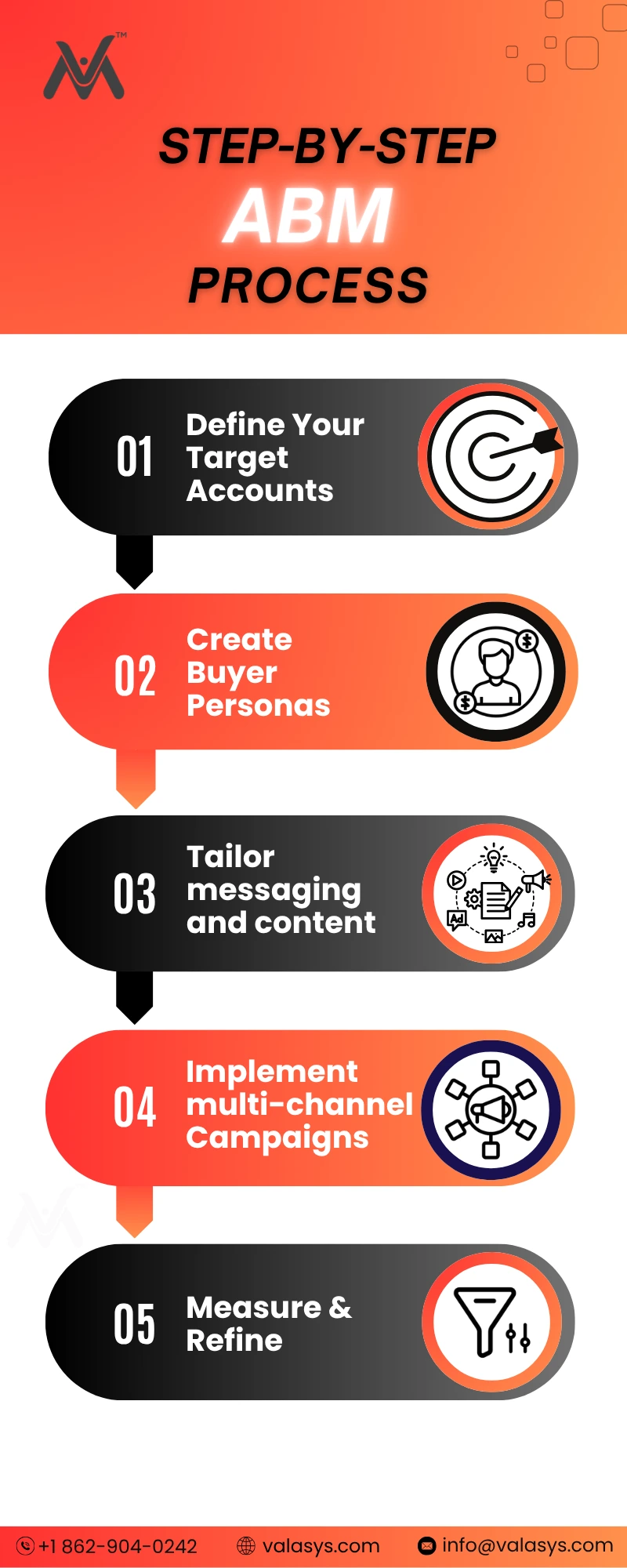Impact of B2B Account-Based Marketing
Do you know 89% of marketers are merging B2B Account-based marketing & Inbound marketing to deliver higher engagement rates? This is why!

Table of Content
Introduction
What is Account-Based Marketing?
ABM & Inbound Marketing
Key Components
Benefits
ABM Tactics
LinkedIn Account-Based Marketing
Introduction:
Imagine a world where you can streamline your sales process and start selling directly to your ideal customers immediately. No more wasting time trying to market to unqualified leads who aren’t a good fit for your business. Efficiency at its maximum: a dream come true for many B2B marketers. With account-based marketing, you can focus on your best-fit, highest-value accounts. This approach aligns your marketing and sales teams, allowing you to engage and delight your target accounts more efficiently.
ABM treats each high-value account as its market and personalizes the buyer’s journey to fit their specific needs. You’ll see better ROI and increased customer loyalty by tailoring all communications, content, and campaigns to these accounts.
What is Account-based Marketing?
Account-based marketing (ABM) is a targeted and personalized marketing strategy focusing on a specific set of high-value accounts rather than a broad audience or individual leads. This approach is commonly used in B2B marketing, where the goal is to build relationships. It provides a tailored experience for key accounts that have the potential to drive significant revenue for a company.
ABM typically involves a collaborative effort between the sales and marketing teams to understand and target specific accounts. Then personalize the buyer’s journey to meet their unique needs and pain points. The objective is to engage these accounts with personalized and relevant content, experiences, and campaigns to build strong, long-lasting relationships.
By focusing on a select group of high-value accounts, ABM allows companies to allocate resources effectively. It also maximizes their return on investment while delivering higher customer satisfaction.
ABM & Inbound Marketing:
Account-based Marketing & Inbound Marketing are a match made in heaven. ABM is a highly targeted strategy that focuses on a specific set of high-value accounts. At the same time, inbound marketing is a foundational approach that attracts customers through valuable content, SEO, and a positive customer experience. Instead of interrupting potential customers, inbound marketing allows you to provide them with information when they are actively seeking it.
Inbound marketing provides a solid foundation for ABM, enabling targeted and efficient resource allocation to high-value accounts. Combining these two strategies allows you to attract a broader range of prospects and create content with dual value, serving both ABM and inbound goals. Additionally, the available software makes it easy to implement both strategies in a complementary way.
Key components of a successful ABM strategy and tips on how to maximize its impact:
-
Define your target accounts:
The first step in an ABM campaign is to define your target accounts. It means identifying the companies most likely to benefit from your products or services. You can start by reviewing your existing customer base and looking for patterns. For example, you may notice that specific industries or company sizes are extreme fits for your offerings. You can also use data and technology to help you identify new target accounts.
Once you have identified your target accounts, prioritizing them is essential. You may have a long list of potential target accounts, but you must focus on the ones with the most significant impact. It could be based on various factors, such as the size of the opportunity, the likelihood of closing the deal, or the customer’s potential lifetime value.
-
Create a buyer persona:
Once you have defined your target accounts, creating a buyer persona for each account is next. It should include job titles, responsibilities, challenges, goals, and buying behaviors.
A clear understanding of your target buyer personas will help you tailor your messaging and offerings to their specific needs and pain points. It will increase the relevance and effectiveness of your ABM efforts.
-
Develop a targeted messaging and content strategy:
With your target accounts and buyer personas defined, it’s time to develop a targeted messaging and content strategy. It includes creating content that speaks directly to the specific pain points and challenges of your target accounts and buyer personas.
Your content should be customized for each target account, considering each account’s unique needs, challenges, and goals. For example, you may create a custom case study for a target account that highlights how your company has helped similar companies in the same industry.
In addition to creating custom content, it’s essential to use a variety of formats, including whitepapers, eBooks, webinars, and videos. The goal is to build a comprehensive library of content that can be used across various marketing channels and touchpoints.
-
Leverage multi-channel campaigns:
ABM requires a multi-channel approach, as you will want to reach your target accounts through multiple touchpoints. It could include email, direct mail, social media, advertising, and events.
The key is coordinating your efforts across all channels and ensuring that your messaging and content are consistent. For example, if you run a direct mail campaign, follow up with an email campaign to reinforce your message.
-
Measure and refine your efforts:
Finally, measure the impact of your AB campaign.
Benefits of Account-Based Marketing
- Keep marketing and sales aligned.
Every organization benefits from team collaboration and improved communication. In the context of account-based marketing, this enhances alignment and focus on shared goals, budget adherence, and clear stakeholder roles. This alignment results in a consistent customer experience for target accounts, allowing for seamless transitions in communication and interactions over time.
- Enhance relevance among high-value accounts.
To maximize relevance, ABM demands personalized content, product information, communication, and campaigns for each targeted account. It shows how your solutions address their specific needs, making your business the best option.
- Deliver consistent customer experiences.
To make ABM successful, deliver consistent customer experiences that treat each account like a unique market. Align Sales and Marketing, keep everyone informed on the buyer’s journey, and offer personalized, timely communications, campaigns, product info, and pricing.
- Measure your return on investment.
ABM allows for easy measurement of return on investment (ROI) per account, enabling you to determine the effectiveness of your assets. By nurturing successful accounts and targeting similar ones, you can drive forward your ABM strategy based on proven results.
- Streamline the sales cycle.
Account-based marketing streamlines the sales cycle by targeting high-value accounts, saving time and resources for more impactful actions.
- Expand business through account relationships.
ABM emphasizes quality over quantity, investing in select high-value accounts for long-term growth. Personalized experiences foster customer loyalty, leading to positive word-of-mouth and business expansion through referrals and testimonials. Retaining customers costs less than acquiring new ones and impacts your bottom line positively.

Account-Based Marketing Tactics
Successful ABM requires working through a list of tactics to ensure effective efforts and investment.
-
Use a Strategic Account Planning Template.
A strategic account planning template can help you align your ABM team and focus on specific account initiatives. The template includes sections to outline: business overview, key initiatives, customer relationship landscape, revenue, competitor analysis, buying process, relationship goals, sales opportunities, targets and risks, and an action plan.
-
Secure organizational ABM alignment.
Make sure your ABM strategy is a team effort involving Marketing and Sales in account planning.
Ask:
- Whom to contact at each account
- What content to attract stakeholders
- Which channels to use to share content
- How to provide support throughout the strategy and sales process.
Secure organizational alignment with account-based marketing is one of the most effective tactics. Your account-based marketing strategy requires all internal stakeholders to be on board. Your business will be able to deliver consistent customer experiences and streamline your process more effectively.
-
Build your ABM team.
Marketing and sales executives need to collaborate on forming an ABM (Account-Based Marketing) team. The team should consist of a minimum of one marketer and one sales representative dedicated to serving the designated accounts. These individuals will be responsible for developing and disseminating content for their accounts and working to secure business deals with the accounts’ buying committees. It is recommended to keep the team size to a maximum of ten sales reps and one marketer. It is also crucial to include other internal stakeholders, such as customer success representatives, in the ABM strategy to ensure they are informed and aligned.
-
Choose an ideal set of target accounts.
Select a set of high-value target accounts to optimize your time and resources. Here are some tips for doing so:
- Utilize LinkedIn to set alerts for your ideal customer profile.
- Establish a system in your CRM that filters incoming leads based on specific criteria (e.g., company size, industry) and categorizes them as ideal customers.
- Determine the characteristics of your most successful deal from the previous year and use that information to identify other potential customers with similar traits.
- Target accounts in a specific industry or geographic area.
- Focus on significant companies and leads that engage with your inbound content but haven’t yet resulted in a deal.
- Designate some accounts as “lighthouse” accounts for reference.
- Limit the number of target accounts per sales rep to ten.
-
Creation of account plans by marketing and sales teams together.
Additional suggestions to ensure the success of account plans:
- Integrate your sales and marketing tools to maintain consistency in your ABM strategy.
- Establish a shared understanding between Marketing and Sales regarding each account’s value proposition and unique selling points.
- Develop or modify content to fit the specific needs of each account.
- Adjust resources and allocate a budget that is specific to each account.6. Attract contacts from high-quality accounts.
To attract the buying committee and stakeholders of target accounts, elevate brand awareness, and increase relevance by personalizing content. Here are some GDPR-compliant methods to attract high-quality accounts:
- Engage accounts on social media platforms
- A podcast or video series
- Sponsor an event or conference booth
- Send direct messages through social media and email
- Utilize LinkedIn InMail outreach
- Build custom landing pages for each account
- Offer gifts for engagement
- Distribute content across relevant channels
- Create ad campaigns and social ads targeted by location, skill, and job title
- Ask for referrals from current contacts and customers
- Invite attendees to events and ask them to bring their colleagues.
-
Measure and analyze your ABM results (and iterate as needed).
To assess the success of your ABM strategy, track key performance indicators (KPIs) such as deal creation, account penetration, account engagement, deal-to-close time, net-new revenue, and percent of deals closed. Monitoring these KPIs will help you identify gaps in your strategy and make adjustments for better results.
LinkedIn Account-Based Marketing
The utilization of social media, particularly LinkedIn, in account-based marketing (ABM) has become a prevalent tactic among marketers, with over 70% of marketers leveraging the platform, as per 2021 Not Another State of Marketing Report. The platform offers a robust feature of Company targeting that grants access to its directory of over 13 million company pages to aid in ABM efforts by allowing the creation of ad campaigns targeting individuals at specific companies. By engaging with the right decision-makers through genuine relationship-building, LinkedIn offers a practical and personal approach to ABM that can be a more effective alternative to utilizing third-party data.



